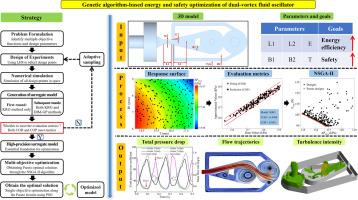Genetic algorithm-based energy and safety optimization of dual-vortex fluid oscillator
IF 9.4
1区 工程技术
Q1 ENGINEERING, MECHANICAL
International Journal of Mechanical Sciences
Pub Date : 2025-09-07
DOI:10.1016/j.ijmecsci.2025.110813
引用次数: 0
Abstract
The dual-vortex fluid oscillator (DVFO) generates periodic axial forces without relying on moving components, effectively reducing friction between the drill bit and the wellbore. However, minimizing the total pressure drop to conserve energy while maintaining optimal axial force for improved drilling safety poses a significant challenge. This study proposes a multi-objective optimization strategy that integrates adaptive sampling, two surrogate modeling methods, and genetic algorithms. Furthermore, enhanced evaluation metrics are employed to assess the fitting and predictive performance of these surrogate models. The results demonstrate that, based on the sample data obtained through adaptive sampling, the deep infinite mixture Gaussian process achieves exceptional accuracy, with all evaluation metrics exceeding 0.94. The optimized DVFO, with a 12.62 % increase in the average flow rate, achieves a 2.47 % reduction in the time-averaged total pressure drop and a 7.09 % reduction in the time-averaged axial force. Sensitivity analysis identifies channel thickness, shunt channel width, offset, and feedback channel width as the most influential parameters. A wider shunt channel, increased channel thickness, and smaller offset collectively reduce the vortex number and strength, thereby minimizing pressure loss. Additionally, the significant reduction in pressure and wall shear stress acting on the leading surface is the primary reason for the decrease in axial force. This research presents an efficient and adaptable strategy for optimizing transient DVFOs, underscoring the importance of geometric design in enhancing flow performance and providing valuable insights for similar fluidic systems.

基于遗传算法的双涡流体振荡器能量与安全优化
双涡流体振荡器(DVFO)产生周期性轴向力,而不依赖于运动部件,有效减少钻头与井筒之间的摩擦。然而,最小化总压降以节约能源,同时保持最佳轴向力以提高钻井安全性是一个重大挑战。本研究提出了一种融合自适应采样、两种代理建模方法和遗传算法的多目标优化策略。此外,采用增强的评估指标来评估这些代理模型的拟合和预测性能。结果表明,基于自适应采样获得的样本数据,深度无限混合高斯过程取得了优异的精度,所有评价指标均超过0.94。优化后的DVFO平均流量提高了12.62%,时间平均总压降降低了2.47%,时间平均轴向力降低了7.09%。灵敏度分析确定通道厚度、分流通道宽度、偏移和反馈通道宽度是最具影响力的参数。更宽的分流通道、增加的通道厚度和更小的偏移量共同减少了涡流数量和强度,从而最大限度地减少了压力损失。另外,作用在先导面上的压力和壁面剪应力的显著减小是轴向力减小的主要原因。本研究提出了一种有效且适应性强的优化瞬态dvfo策略,强调了几何设计在提高流动性能方面的重要性,并为类似流体系统提供了有价值的见解。
本文章由计算机程序翻译,如有差异,请以英文原文为准。
求助全文
约1分钟内获得全文
求助全文
来源期刊

International Journal of Mechanical Sciences
工程技术-工程:机械
CiteScore
12.80
自引率
17.80%
发文量
769
审稿时长
19 days
期刊介绍:
The International Journal of Mechanical Sciences (IJMS) serves as a global platform for the publication and dissemination of original research that contributes to a deeper scientific understanding of the fundamental disciplines within mechanical, civil, and material engineering.
The primary focus of IJMS is to showcase innovative and ground-breaking work that utilizes analytical and computational modeling techniques, such as Finite Element Method (FEM), Boundary Element Method (BEM), and mesh-free methods, among others. These modeling methods are applied to diverse fields including rigid-body mechanics (e.g., dynamics, vibration, stability), structural mechanics, metal forming, advanced materials (e.g., metals, composites, cellular, smart) behavior and applications, impact mechanics, strain localization, and other nonlinear effects (e.g., large deflections, plasticity, fracture).
Additionally, IJMS covers the realms of fluid mechanics (both external and internal flows), tribology, thermodynamics, and materials processing. These subjects collectively form the core of the journal's content.
In summary, IJMS provides a prestigious platform for researchers to present their original contributions, shedding light on analytical and computational modeling methods in various areas of mechanical engineering, as well as exploring the behavior and application of advanced materials, fluid mechanics, thermodynamics, and materials processing.
 求助内容:
求助内容: 应助结果提醒方式:
应助结果提醒方式:


